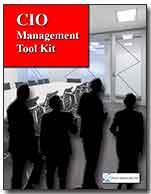Immediate To Do Tasks for CIOs and IT Managers at Start of Recession
Recessions impact every enterprise - best to be prepared
 With the credit crunch CIOs need to take immediate proactive steps if they want to help their enterprises to survive the economic downturn and be able to quickly adjust to the new realities that enterprises around the globe face.
Those steps include:
With the credit crunch CIOs need to take immediate proactive steps if they want to help their enterprises to survive the economic downturn and be able to quickly adjust to the new realities that enterprises around the globe face.
Those steps include:
- Immediately create an updated Business IT plan assuming the worst will happen - Prioritize all IT and enterprise initiatives.
- Put in place a hiring freeze - Proceed to hire only if position is need to comply with the update Business IT plan.
- Evaluate all spending plans for projects and staffing - Will the current situation still support them?
- Evaluate the need to continue existing consulting contracts - What costs and risks are faced if the contracts are terminated or suspended immediately?
- Convert any "key" contractors to employees - If the role the contractor is playing within the enterprise is critical convert it to an employee position and be ready to explain the increase in head count.
- Suspend any upgrades in software and hardware that are not critical to the enterprise's success - Determine if the ROI is still the same given today's situation.
- Update Business Continuity & Disaster Plans - business interruptions occur when you least expect them
Business Continuity & Disaster Planning Requirements Defined
 Business Continuity and Disaster Planning require data
consistency with the synchronous replication of data over long-distances and / or journal replication to protect against local and wide-area disasters. This technology provides other benefits, including:
Business Continuity and Disaster Planning require data
consistency with the synchronous replication of data over long-distances and / or journal replication to protect against local and wide-area disasters. This technology provides other benefits, including:
- Maintaining more efficient data currency. Using synchronous replication over a short distance in a campus or metropolitan area cluster provides the highest level of data currency without undue impact to application performance.
- Permitting swift recovery. A campus/metropolitan cluster implementation allows for fast automated failovers after a local area disaster with minimal to no transaction loss.
- Permitting recovery even when a disaster exceeds traditional regional boundaries. A wide-area disaster could disable both data centers 1 and 2, but with some manual interaction, operations can be shifted to data center 3 and continue after the disaster.
- Shifting to staffing outside the disaster area. A wide-area disaster also affects people located within the disaster area, both professionally and personally. By moving operations out of the region to a remotely located recovery data center, operational responsibilities shift to people not directly affected by the disaster.
Janco has defined a Template with a Backup and Backup Retention policy that is a complete policy which can be implemented immediately. The document is provided in MS WORD format and is easily modified.



